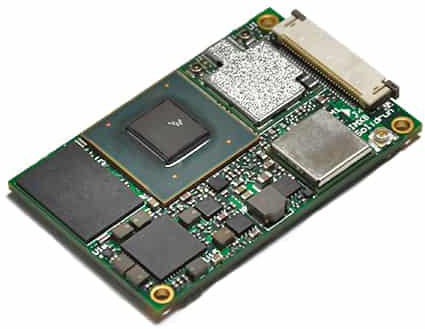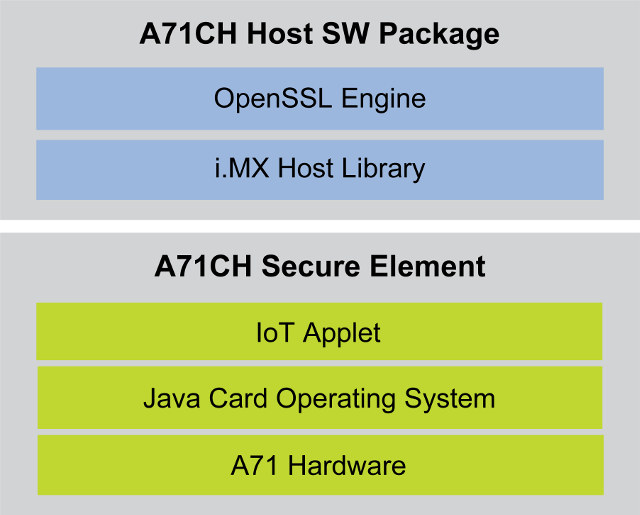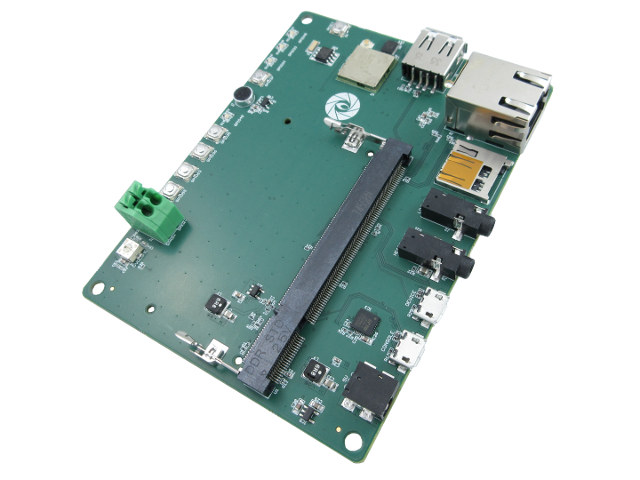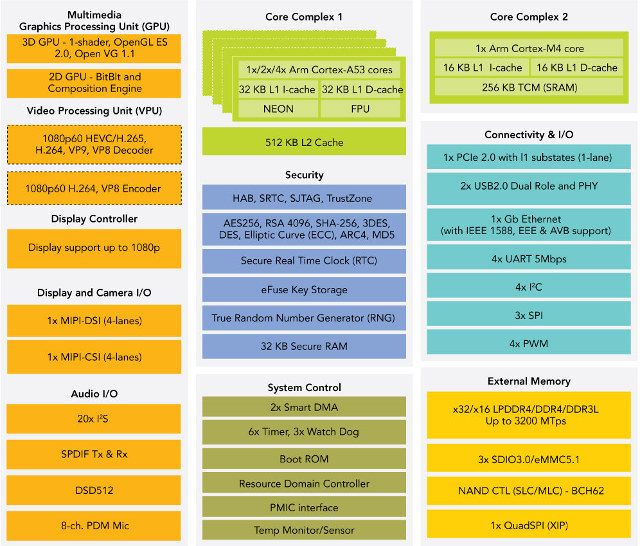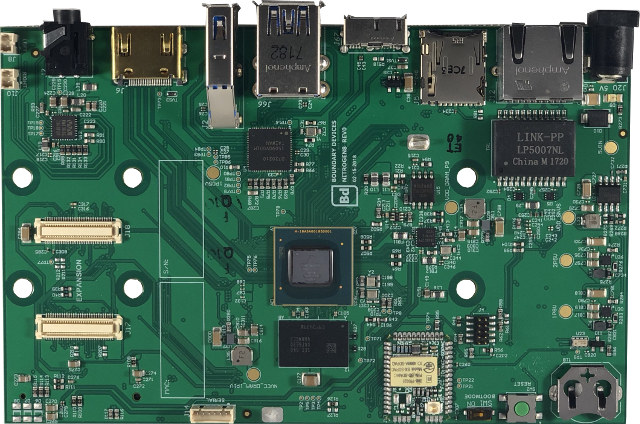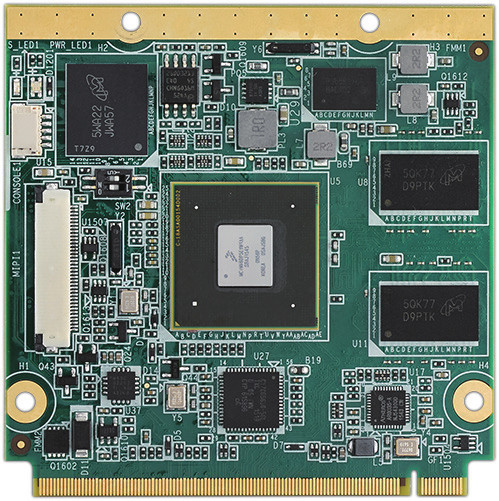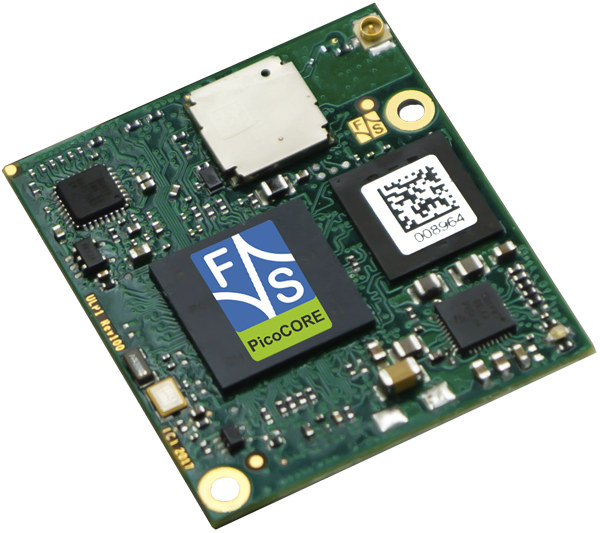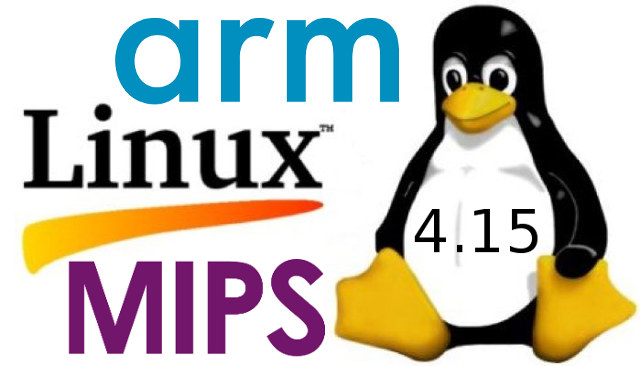Solidrun has several products based on NXP i.MX6 processors including i.MX6 SoMs, Cubox-i mini PCs, and HummingBoard Edge development board, which were launched between 2013 and 2015, and still sold to this day. But the company has now launched refreshes for all those products based on the new i.MX 8M 64-bit Arm processors with i.MX 8M industrial systems-on-module, Cubox Pulse mini PC, and HummingBoard Pulse SBC. Solidrun i.MX 8M SoM Three different modules – which differ only by their processor and max memory capacity – are available with the following specifications: SoC SOM i.MX8 Dual – NXP i.MX 8M Dual core ARM A53 @ 1.3 GHz (up to 1.5 GHz), Arm Cortex-M4, and Vivante GC7000 Lite GPU SOM i.MX8 Quad Lite – NXP i.MX 8M QuadLite quad core ARM A53 @ 1.3 GHz (up to 1.5 GHz), Arm Cortex-M4, and Vivante GC7000 Lite GPU SOM i.MX8 Quad – NXP i.MX […]
NXP Unveils A71CH Secure Element Chip for Secure Peer-to-Peer or Cloud Connections
The industry clearly has an issue at hand with the security of the Internet of Things, and the problem is complex as some devices are easily accessible due to bad configuration (e.g. default username/password), while others may have security flaws at various levels of the software stack from the low level bootloaders to the operating systems, and applications. Nowadays, devices also need to be upgradeable, and communicate with the cloud, and that introduces other attack vectors in case malignant firmware is installed instead, or a man-in-the-middle attack occurs. While some people may claim security can be achieved by software only, we are seeing security evolving towards combined software and hardware solutions, for example with Arm Trustzone built into SoCs, but some companies are also introducing Secure Element chip, which Samsung has already done and integrated into their Artik modules to secure data from the hardware to the cloud. NXP has […]
Gumstix Chatterbox is a Customizable, AVS-Ready Development Platform based on Toradex Colibri i.MX7 SoM
There are several official Amazon Voice Service (AVS) development kits, and we’ve already covered a few of them with the likes of Allwinner 3-Mic Far Field AVS Development Kit or Intel Speech Enabling Developer Kit, but you can also design your own board conformant to Amazon’s Alexa Voice Service functional design guide. That’s exactly what Gumstix has done with Chatterbox carrier board for Toradex Colibri i.MX7 system-on-module powered by NXP i.MX7 Arm Cortex A7 processor. Designed in Geppeto, the board includes a 2.5-Watt speaker driver, an on-board microphone, and Line IN and headphone jacks, as well as WiFi, Bluetooth and Ethernet for connectivity. Gumstix Chatterbox specifications: Colibri iMX7 SO-DIMM socket Storage – microSD card slot Audio – On-board microphone; 2.5W speaker driver; Line-in & headphone jacks Connectivity – Gigabit Ethernet, 802.11 b/g/n WiFi & Bluetooth 4.1 LE (TI WiLink8 WL1831) with u.FL antenna connector USB – 1x micro USB […]
NXP i.MX 8M Mini Low Power Cortex A53/Cortex M4 Processor to be Manufactured using 14LPC FinFET Process Technology
NXP i.MX 8, i.MX 8M, and i.MX 8X processors are barely available, but the company has already announced another member of their i.MX8 family with i.MX 8M Mini processors with one to four Cortex A53 application cores, one Cortex-M4F real-time core, 2D/ 3D graphics accelerator, and support for 1080p video playback and output. Apart from the lack of 4K support, that looks about the same as i.MX 8, but there’s one important difference: the manufacturing process. i.MX 8M Mini processors are manufactured using 14LPC FinFET process technology allowing the Cortex A53 cores to reach 2.0 GHz, and the Cortex-M4F core can be clocked up to 400+ MHz. Some video interfaces have also been removed from the new processor such as embedded DisplayPort and HDMI 2.0a. NXP i.MX 8M Mini key features: Application cores – One to four Arm Cortex-A53 cores up to 2GHz Real-time core – Arm Cortex-M4 at speeds […]
Nitrogen8M Single Board Computer with NXP i.MX 8MQuad Processor Comes with Up to 4GB RAM, 128 GB Storage
Boundary Devices Nitrogen6X was one of the first boards based on Freescale i.MX 6 processor when it launched in 2012, and even I never owned their board personally, I liked the fact the company published frequent updates about software development on their blog. With NXP i.MX 8 processors now officially available, the company introduced an update to their SBC with Nitrogen8X powered by NXP i.MX 8MQ quad-core processor, with 2 to 4 GB LPDDR4 RAM, 8 to 128 GB flash, a certified wireless module for WiFi and Bluetooth, and more. The form factor has changed dramatically, however. Nitrogen8M specifications: SoC – NXP i.MX 8MQuad ((Dual, QuadLite available on request) with four Cortex A53 core @ up to 1.5 GHz, one Cortex-M4F real-time core, and a Vivante GC7000Lite 2D/3D GPU System Memory – 2 or 4GB LPDDR4 (2GB standard) Storage – 16MB QSPI NOR Flash, 8GB eMMC flash (expandable to 128 […]
Advantech ROM-7720 is a Qseven 2.1 Compliant i.MX 8 QuadMax Computer-on-Module
Many solutions based on NXP i.MX8 processors are likely to be announced during Embedded World 2018 next week. We’ve already seen several NXP i.MX 8M Cortex A53 based modules such as Variscite DART-MX8M or Compulab CL-SOM-IMX8 systems-on-module, and more are coming. One of those will be Advantech ROM-7720 computer-on-module (CoM) featuring the top of the line NXP i.MX 8 QuadMax Cortex A72/A53 processor and following QSeven 2.1 specifications / form factor. Advantech ROM-7720 CoM specifications: SoC – NXP i.MX 8QuadMax processor with 2x Cortex A72 cores @ up to 1.6GHz, 4x Cortex A53 cores, 2x Cortex-M4F real-time cores, a HiFi 4 DSP, and 2x Vivante GC7000XSVX GPUs System Memory – 2GB LPDDR4 @ 1600 MHz (optional 4GB RAM) Storage – 8 GB eMMC Flash for OS, 64 MB Quad SPI Flash for boot loader Video Output / Display I/F 2x 24-bit LVDS, 1366 x 768 for 1ch; 1920 x 1080 […]
PicoCORE MX7ULP is a Compact Module Based on NXP i.MX 7ULP Ultra Low Power Processor
NXP unveiled another variant of their i.MX 7 Cortex A7 processor last year, and I missed it. NXP i.MX 7ULP offers many of the same features as i.MX 7, but is manufactured using FD-SOI (Fully Depleted Silicon On Insulator) process technology to offer lower power consumption, as low as 15 mW or less in deep sleep, or 17 times less in comparison to i.MX 7 devices, while the dynamic power efficiency is improved by 50 percent on the real time domain (Cortex-M4). I found out about it thanks to an email from F&S Elektronik Systeme about the introduction of their PicoCORE MX7ULP module – based on i.MX 7ULP processor – at the Embedded World 2018 conference. PicoCORE MX7ULP CoM specifications: SoC – NXP i.MX 7ULP Arm Cortex-A7 processor @ up to 800 MHz, with Arm Cortex-M4 real-time core, and 2D/3D graphics accelerator System Memory – Up to 1GB LPDDR3 Storage […]
Linux 4.15 Release – Main Changes, Arm and MIPS Architectures
Linus Torvald has released Linux 4.15 last Sunday: After a release cycle that was unusual in so many (bad) ways, this last week was really pleasant. Quiet and small, and no last-minute panics, just small fixes for various issues. I never got a feeling that I’d need to extend things by yet another week, and 4.15 looks fine to me. Half the changes in the last week were misc driver stuff (gpu, input, networking) with the other half being a mix of networking, core kernel and arch updates (mainly x86). But all of it is tiny. So at least we had one good week. This obviously was not a pleasant release cycle, with the whole meltdown/spectre thing coming in in the middle of the cycle and not really gelling with our normal release cycle. The extra two weeks were obviously mainly due to that whole timing issue. Also, it is […]

